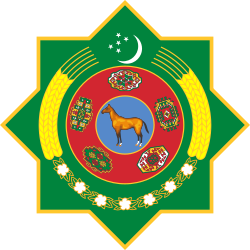 |
|---|
A referendum on extending President Saparmurat Niyazov's term until 2002 was held in Turkmenistan on 15 January 1994. [1] Official results showed that the proposal was approved by 99.99% of voters with a 100% turnout. [1]
 |
|---|
A referendum on extending President Saparmurat Niyazov's term until 2002 was held in Turkmenistan on 15 January 1994. [1] Official results showed that the proposal was approved by 99.99% of voters with a 100% turnout. [1]
In 1985, Saparmurat Niyazov, then the first secretary of the Ashgabat Communist Bloc, was handpicked by Soviet leader Mikhail Gorbachev into elite politics as a replacement for Muhammad Gapusov, the First Secretary of the Communist Party of Turkmenistan. [2] This replacement was part of the Central Asian purges in the wake of the Uzbek cotton corruption scandal. [2] In January 1990 Niyazov was elected to the Supreme Soviet of the Turkmen Soviet Socialist Republic and was appointed as its chairman. [1] [2] Two months later, Niyazov was elected by the Supreme Soviet to the new office of president. [1] Following in the footsteps of his predecessor(s), Niyazov prevented Gorbachev-era reforms from having any tangible effect on what was among the most conservative federal republics of USSR. [1] [2] Opposition groups were routinely disbanded and members exiled on charges of anti-Soviet activities. [2]
In October 1990 his presidency was "unanimously" confirmed by the masses. [1] A year later he led Turkmenistan to secede from the Soviet Union despite an initial reluctance, and decreed a new constitution that promulgated a presidential government. [2] [3] The political atmosphere of the newly independent state remained as conservative as before, with Niyazov finding "classic, democratic formulas [..] that worked out in some prosperous Western country" unsuitable for Turkmenistan. [2] In 1992 Niyazov was re-elected unopposed as president, receiving over 98% of the vote. [1] Following these victories, Niyazov went further in manifesting a totalitarian regime based on a cult of personality. [1] [2] [3]
Voters were asked to decide whether to prolong the term of President Niyazov by six years, until 2002. [1] The question was worded "Do you support extending the term of President Saparmurat Niyazov until 2002?"
According to official statistics, 100% of the registered voters (1,959,637) participated in the referendum. [1]
| Choice | Votes | % | |
|---|---|---|---|
| For | 1,959,408 | 99.99 | |
| Against | 212 | 0.01 | |
| Total | 1,959,620 | 100.00 | |
| Valid votes | 1,959,620 | 100.00 | |
| Invalid/blank votes | 17 | 0.00 | |
| Total votes | 1,959,637 | 100.00 | |
| Registered voters/turnout | 1,959,637 | 100.00 | |
| Source: Nohlen et al. [1] | |||
The promised elections were not held in 2002 as Niyazov had himself declared President for life by the Assembly on 28 December 1999. [1] He would rule until his death in 2006.